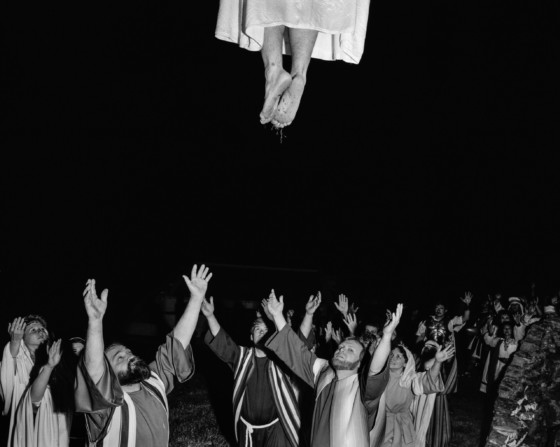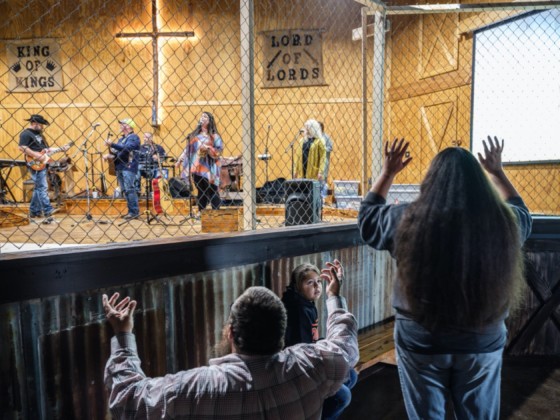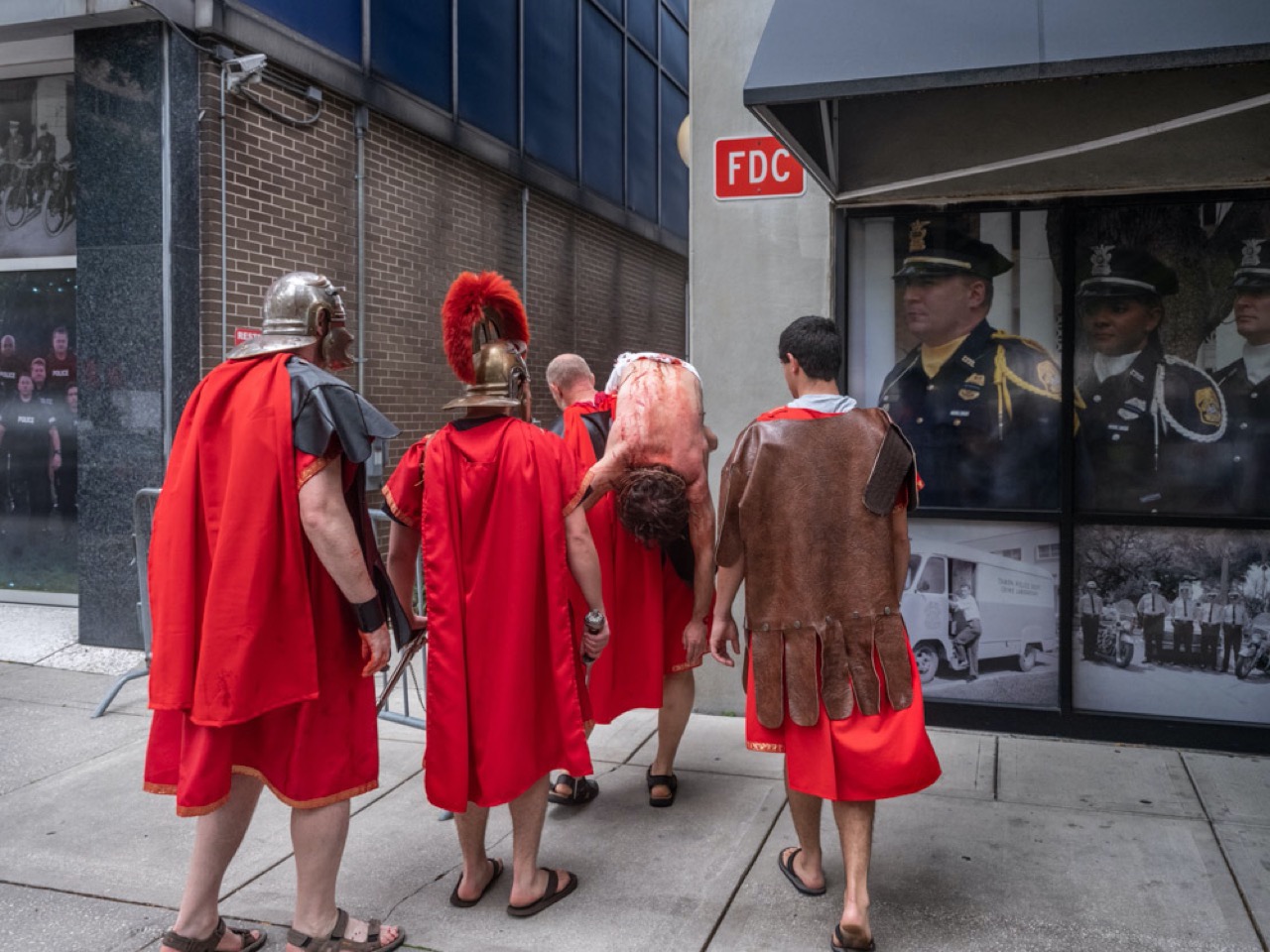God Inc II
Carl De Keyzer’s new book examines religion as a product, giving an updated insight on how faith shapes the United States today
In 1990, Carl De Keyzer’s seminal project God Inc interrogated the powerful grip of religion over the United States. Completed over the course of one year, De Keyzer relocated to America with his wife and child in a campervan he had bought for the trip and dedicated himself to documenting the influences and manifestations of the church around the country. Observing everything from the most routine and ordinary expressions of faith to the spectacles of Christian plays and KKK rallies, the project documented the often-bizarre rituals associated with, as well as the politics underlying, religion in a context where faith has existed in its most commodified form in the world.
In 2019 and 2020, De Keyzer returned to the USA to update the project. He was interested in how, over the last 30 years, technology and new practices of religion had helped or hindered the US’s relationship with God. His findings are now published in a new edition of the project, represented in two-parts, God Inc I and God Inc II, which also reveal 27 previously unpublished photographs from the original trip.
Here, we share extracts from philosopher Johan Braeckman’s introductory text for the new publication, which poses the question of why exactly humans are driven by an urge to believe. The text is accompanied by images from both parts of De Keyzer’s book: color images from God Inc II, made in 2020, as well as previously unpublished images from God Inc I.
You can buy a copy of God Inc II here.
The Enigma of Religion Deciphered?
Imagine: we are going back in time, to the 1980s. It is a sultry summer evening. A spaceship lands in your back garden. It has travelled from a planet many light years away. Some aliens step out of the craft. Before you can recover from your astonishment, they explain that they are part of a scientific expedition. Their government has sent them here on a mission to study the ways of life of all intelligent organisms in our corner of the universe. Not a difficult job, they admit. There was a handful of relevant species in a neighboring solar system, but that encounter yielded little in the way of scientifically meaningful data. Despite the presence of billions of planets, intelligence seems to be a rare commodity in the cosmos. Their hopes of sending home a compelling report are now entirely focused on us. They cracked our language code by picking up radio waves. That was not so difficult. But listening in on the information we exchange is not enough. If they are to really understand us, they need more. They want to observe us in the wild, too. But time is short. There are several other planets, a little further than Proxima Centauri, that might be worth a visit. After that, it is a long journey home. They ask you for advice. If they want to understand the human race, what should they study? What will seem alluring and exotic to people back at home? What behavioral characteristics define our species?
You scratch your head, and ponder. What is so specific to our kind that it will fascinate people on the other side of the cosmos? Suddenly, the answer is self-evident: it is religion. You explain it as best as you can, but the aliens gawp at you, dumbfounded. This tells you that you have found the right subject matter. Every human knows what religion is, but almost no one gives much thought to what religion is really all about. You do your utmost to offer a lucid explanation. Religion has to do with a god or gods, with special books, with creation and destruction, life and death, prayers and rituals, the supernatural and sacrifices, the sacred and hallowed, that kind of thing. But, for the aliens, it doesn’t seem to ring any bells. A god? They have never heard of such a thing. A being that is responsible for the creation of the entire cosmos? What a bizarre concept. They consider it quite peculiar.
Proximate explanations of religion
In The Essence of Christianity (1841), [Ludwig] Feuerbach claimed that it was not God who created man in his image and likeness, but vice versa. Man created the image of God as a reflection of himself, but magnified to the extreme. Feuerbach thus reduced theology to anthropology. Only man creates religion. Man is the creator, God is his creature. He projects the positive but flawed qualities of man, such as knowledge, self-insight and power, onto the fiction of the image of God, but in perfected form: absolute knowledge, total self-insight and unlimited power. God is the fictional, idealized perfection of man. The Supreme Being is a form of wishful thinking: it is the being that man would like to be. Feuerbach points out that religion creates alienation. It creates a distance between man and his religious fiction by emphasizing the contrast between finite, imperfect man on the one hand and his infinite, perfect creation on the other.
Karl Marx saw value in Feuerbach’s analysis, but believed it did not go far enough. Marx argued that it explained why man creates an image of God compared to which he then feels inferior, but not how we can eliminate religious alienation. Feuerbach offered a purely psychological explanation, but a deeper analysis was required. In his book The German Ideology (written in 1846), Marx argued that man projects himself onto an image of God in reaction to real-world social and economic inequalities. Capitalism results in the distortion of social relations; people are alienated from each other, from themselves and from their labor and the products they make. Religion, like all cultural products, is the consequence of economic relations and the way that resources are distributed. In Marxist terms, religion belongs to the ruling class, but is determined by the economy, the base. In an earlier text about the philosopher Hegel, Marx had described religion as “the opium of the people”: “Religion is the sigh of the oppressed creature, the heart of a heartless world, as it is the spirit of soulless conditions. It is the opium of the people.” The oppressed man creates religion for himself, to seek solace in the face of his unbearable circumstances. But it is a false form of comfort, said Marx, which does nothing to remedy the underlying causes of the religious man’s misery. On the contrary, religion benefits the exploiters. It is a device to keep the people in ignorance of the true circumstances in which they and society find themselves. If the proletariat is no longer exploited by capitalism, religion will automatically die a silent death. After all, there will no longer be a need for man to project himself onto the image of an almighty god, as Feuerbach described.
The cognitive science of religion
A core aspect of the cognitive science of religion is the modular organization of our mental abilities. Through evolution and selection, we possess many cognitive possibilities, which some researchers call modules or heuristics. This can be understood as follows: just as our body is made up of numerous evolutionary adaptations, for example, organs such as the heart, lungs and liver, or regulatory mechanisms for temperature and sleep, or structures such as knee joints and jaw muscles, our mental software also has various mechanisms to solve problems that have an effect on survival and reproduction. Consider, for example, the psychological properties—modules—that make it possible for children to learn a language very quickly; our mental skills to recognize faces and interpret intentions; the intuitive way in which we classify, deduce and generalize; or the spontaneous distinction that even young children can make between the organic and the inorganic, between the material and mental domains, and so on.
We rarely, if ever, need to learn all these special abilities. We have them thanks to our evolutionary history and we use them to give meaning and purpose to the world, to see structure and recognize patterns in that structure. In this regard, it is helpful to clarify the distinction between innate and learned. Obviously, we are not born with the knowledge of English or any other language. We learn a language. But the skills we need to learn a language are innate. The central thesis of several authors is now that religion grafts onto or, as it were, hitches itself to, an array of psychological mechanisms that have evolved because they are functional to solving problems that have nothing to do with religion.
Let me give an example. People are able, quickly and efficiently, to recognize faces as faces. Even babies possess this skill. They spend more time looking at manipulated photos of faces where the features aren’t quite right, for instance because the nose is on the forehead, than at normal faces. From this, we can deduce that babies already have an expectation pattern about what faces look like. For obvious reasons, such a cognitive mechanism, or a mental module, is particularly useful. After all, faces are extremely important to us, because they generally belong to people. Our ability to recognize faces as faces is, in a sense, hyper-sensitive. It works too well, as it were. That is why we sometimes see faces in the clouds, in the bark of a tree or in the mould that grows in your bathroom. Those faces aren’t real, but they do trigger the mental modules that allow you to recognize faces. Evolutionary psychologists compare it to a smoke detector. To function properly, this mechanism also needs to be a little hyper responsive. After all, it is better to mistakenly overestimate—someone lights a cigar, and the alarm goes off—than mistakenly underestimate: a fire breaks out, but the smoke detector thinks it is a cigar. On the overestimating side, we can afford many mistakes, but none on the underestimating side. In an analogous way, we see more faces than there actually are.
"...in roughly two hundred generations, people [may] look at Carl De Keyzer’s photographs in the same way that we look at Stonehenge, or at the prehistoric statue known as the Löwenmensch or Lion-man."
-
The cognitive science of religion endeavors to show that we do not see faces in the clouds simply as a trivial by-product. A whole complex of anthropomorphic aspects are attached to it. This is referred to as a Hyperactive Agency Detection Device. That’s quite a mouthful, but the bottom line is that we have mental modules that allow us not only to recognize faces, but also to spontaneously link the right psychological faculties to them. Think of intentions, making plans, purposeful reasoning and action, emotions and moral views. Those mental modules are hyperactive; like the smoke detector, they are a tad too sensitive. When we see a real face, we don’t simply read it as a face. We automatically try to decipher the thoughts that lie behind it. We want to find out what the subject associated with the face thinks, wants, is planning, expects, fears and so on. The key point now is that, because it is hyperactive, our Agency Detection Device inevitably also assumes agents, i.e. subjects with thoughts, intentions and plans, at work behind phenomena and events that, in reality, have no psychological charge at all. For example, when no one knew what comets were, they were interpreted as messages, generally harbingers of bad news. Well, if comets deliver a message, then of course there must be someone—an agent—sending the message. Such a person must have intentions and make plans, including conveying information. In addition, he must have exceptional abilities, otherwise he would be unable to make a celestial object appear to us. Essentially, we spontaneously, intuitively, postulate a super-subject behind special events such as the appearance of a comet. But also behind the origin of the cosmos, of life, and man; behind sickness and death; behind special natural phenomena or dramatic events, and so on. It is not difficult to view the many thousands of gods that man has conceived as cultural expressions of the psychology of the super subject.
Religion in flux
The discipline [the cognitive science of religion] is still evolving, but it holds the promise of offering a scientifically convincing explanation for the origin and the why of religion. This causes psychologist Jesse Bering to write, at the end of The God Instinct (2011): “We are the first generation, in the history of our species, to be confronted directly by the full scientific weight of an argument that renders a personal God both unnecessary and highly unlikely.” Bering makes a strong point, of that there is no doubt. But the findings of the cognitive science of religion have yet to filter through to the general public. Moreover, throughout the world, children’s exposure to religious instruction and indoctrination far outstrips their introduction to science and critical thinking.
Looking specifically at the situation in Islamic countries and in a Christian country such as the United States, it looks as though it may take quite some time before Bertrand Russell’s prediction [that religion will end] comes true. This is something that also seems to be confirmed by Carl De Keyzer’s photographs. The United States, a Western country where people can easily gain access to scientific knowledge, is religious through and through. Over forty percent of the population rejects the theory of evolution and takes the book of Genesis more or less literally. Even now, the Evangelicals continue to wield enormous power and influence.
Nevertheless, recent studies show that even in the United States, the number of people who describe themselves as Christian is rapidly declining. Research carried out by the Pew Research Center from 2018 and 2019 shows that 65% of residents of the United States consider themselves Christian, which represents a decrease of 12% from a decade ago. Those who refer to themselves as nonreligious—as atheist, agnostic or ‘nothing in particular’—comprise 26% of the population. Ten years ago, that was 17%. Both Protestantism and Catholicism are losing believers in the United States. In 2020, 43% of Americans identify with the Protestant faith. In 2009 this was still 51%. The Catholic community shrank from 23% to 20% in the past decade. The number of people who participate in religious ceremonies reveals the same, sharply declining, trend. The downturn in the number of Christians is not only relative to other faith communities, but also in absolute numbers. In 2009, there were approximately 233 million adults in the U.S., 178 million of whom identified as Christian. Since then, the adult population of the U.S. has swelled by 23 million, but the number of Christians has dropped to 167 million. During the same time span, the demographic that refers to itself as ‘religiously unaffiliated’ increased by 30 million. For the last ten years, the number of Mormons has held steady at 2%, which matches the percentage of Jews in the U.S. The community of Muslims in the U.S. remains small, at 1%, the same as the percentage of Buddhists and Hindus, respectively. Another 3% call themselves ‘spiritual’. Thirty years have elapsed since Carl De Keyzer took the photographs in God Inc I and the images in God Inc II. Intriguingly, the intensity of the individual religious experience seems as strong as ever, while there is no denying that the sociological influence of religion is on the wane.
How can we explain this striking change in the American religious landscape? Clearly, several factors are at play. Perhaps it can be attributed to the sex scandals within the Catholic Church, or the questionable moral conduct of several evangelical preachers. The terrorist acts of the past decades, which seem to have been predominantly Islamic, also show religion in a bad light. Are a growing number of people drawn towards science, or the humanist view of man and the world? Are people finding meaning and ways to develop a positive identity elsewhere? Or have people become increasingly indifferent? Perhaps we are discovering more and more ways of belonging to a group, outside of the traditional religious communities. Or do the moral values and norms associated with religion appeal to fewer and fewer people? Books by authors who are critical of religion—including Sam Harris, Richard Dawkins and Christopher Hitchens—may be partly responsible for the findings of the Pew Research Center. There is no doubt that the economy also plays an important role. Religion is far more intertwined with capitalism in the United States than anywhere else in the world. It is no accident that Carl De Keyzer’s books, which contain only photographs of religious life in the United States, are entitled God Inc.
Finally. In the meantime, are we able to tell the aliens who landed in your back garden in the 1980s something meaningful about religion? As I said, I think we can. We know that they are familiar with the theory of evolution. It therefore cannot be too difficult to explain to them the evolutionary perspective on belief in gods and the supernatural, which is the driving force behind the cognitive science of religion. Yet religion itself may remain unfathomable to them because they do not possess the central psychological traits of which religious ideas are—for human beings—a quasi-spontaneous corollary. They would, however, be able to understand the logic of the explanatory arguments.
By analogy, with reference to a well-known text by the philosopher Thomas Nagel: people cannot fully comprehend what it means to be a bat, but at a certain cognitive level, we understand how echolocation allows bats to fly in the dark and catch insects. Perhaps, thanks to their highly developed knowledge of data analysis and probability, the aliens are much better equipped than we are to make predictions about the future of religion. Who knows, they may foretell the extinction of religion, and that, in roughly two hundred generations, people will look at Carl De Keyzer’s photographs in the same way that we look at Stonehenge, or at the prehistoric statue known as the Löwenmensch or Lion-man. It is instantly recognizable as something created by human beings, yet nonetheless enigmatic and mysterious. Time will tell.


































